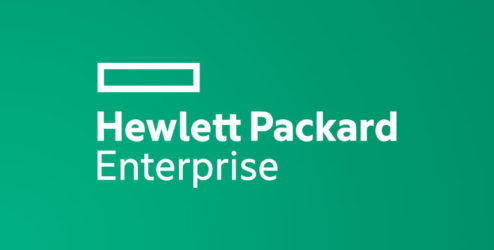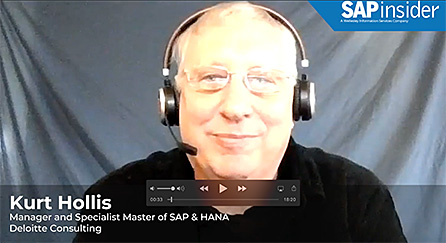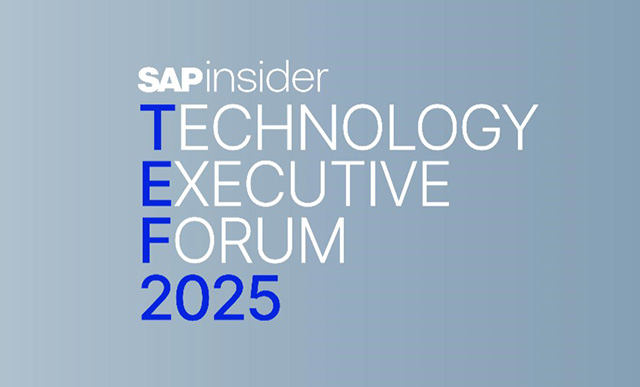How Will I Be of Service to SAP Customers Each Day?
Key Takeaways
Clean: It runs with a clean core or ERP system and minimal technical debt — not tremendous amounts of custom code.
Intelligent: It leverages its data and solutions, including SAP technologies, to build intelligence and insights — to drive automation, service, new efficiencies, and growth.
Responsive: It relies on a cloud-enabled environment that allows it to expand and contract as needed, pivoting as necessary.
Being of Service to SAP Customers
As a Principal at Deloitte Consulting LLP, Kelly Herod leads global SAP business transformations. Specifically, she leverages her finance and technology background to optimize companies’ finance processes, transform their shared services organizations, and implement next-generation technologies to SAP customers.
Besides serving her clients, Herod leads Deloitte Consulting‘s US SAP Practice. Prior to her current role, she held many leadership roles within Deloitte Consulting, including SAP Finance Practice Leader, Mid-America SAP Leader, and SAP Alliance Leader. Most recently, she led the US SAP Assets and Innovation team, which worked on creative initiatives to reimagine the future of SAP. After her success with that team, in June 2020, Herod moved into her new position as US SAP Practice Leader amid an unprecedented global pandemic. After completing 100 days on the job, Herod spoke with SAPinsider about what Deloitte Consulting’s US SAP Practice has been doing to help SAP customers. In the following Q&A, which summarizes this conversation, she shares her perspective as the head of this practice and her personal views as a leader and a woman in the SAP space.
Q: What are the top priorities you are focused on in your new role at Deloitte?
From a short-term goal perspective, we have made a rapid pivot to a fully virtual business model. Over the last couple of years, we had been on a journey within Deloitte to transform our operating and talent models. This included reimagining how we think about around-the-clock working environments and teams and where people need to be based. So, when we encountered COVID-19 in 2020, we were ready and able to quickly develop. And now we are even speeding up some initiatives we had originally planned for later in this fiscal year or next year, because we have shown that we can be flexible with our on and offsite work models to create the best value for our clients.
Explore related questions
For the long term, we are focused on helping our clients activate the “Kinetic Enterprise.” While in the past, technology solutions and processes were “built to last,” the future is about solutions and processes that are “built to evolve.” With technology changing faster than ever before, we must build businesses themselves to develop — or “kinetic” — with the technology and solutions as the dynamic underlying infrastructure. For us, a Kinetic Enterprise has four pillars:
- Clean: It runs with a clean core or ERP system and minimal technical debt — not tremendous amounts of custom code.
- Intelligent: It leverages its data and solutions, including SAP technologies, to build intelligence and insights — to drive automation, service, new efficiencies, and growth.
- Responsive: It relies on a cloud-enabled environment that allows it to expand and contract as needed, pivoting as necessary.
- Inclusive: It operates with a complete, connected ecosystem of applications, services, and capabilities — beyond just the SAP core — to support more effective business processes and rapid innovation.
Q: Have you seen any recurring themes, shifts, or challenges (aside from COVID-19) in bringing that Kinetic Enterprise strategy to life for clients?
Considering the end-of-maintenance date for SAP ECC shifting from 2025 to 2027, the number one question I hear most executives grappling with is when and how to start their SAP S/4HANA implementation, including what order they should bring their business onto the solution and defining the business value. To address this, we have been bringing to market additional business value and business case solutions — in particular, for clients that have been on older SAP versions. Through these solutions, we look under the hood of what clients currently have, create a heat map of the business value opportunities, and translate that into hard-dollar savings that can be achieved, which can help fund their transformation journey to SAP S/4HANA.
The bottom line is that SAP implementations and transformations are changing. It’s no longer a once-and-done type of project. In response, there has been a lot of effort put forth to address that and make the implementation experience more efficient. For instance, Deloitte came up with a “touchless build” concept where the technology does the work so that instead of putting energy into how to execute the implementation, people can focus on how to get the desired business value from the software and transform the business.
Considering all those challenges, along with the technological advances around SAP S/4HANA, artificial intelligence, machine learning, and cloud technology, Deloitte has launched a brand-new solution called “Kinetic Finance Startup” where the machines do the heavy lifting for a Central Finance implementation of SAP S/4HANA. From day one, the solution connects to your existing finance systems, extracts your data, harmonizes it, and over a weekend configures a net-new implementation of the SAP solution — all at the touch of a button. So, when we come in to meet with you on Monday, we are looking at a real-life system with your data. That’s powerful because it not only addresses all those pain points — by decreasing the time needed to do the full program, reducing the number of resources required, and lowering costs — but also enables clients to experience the system using their own data, which helps with change management. All that together is what allows our Kinetic Finance Startup solution to help clients jumpstart their SAP S/4HANA for central finance implementations.
Seeing is believing, which serves as a catalyst for getting things going. The goal in creating this solution was to bring things to life so clients can see them, feel them, and touch them, versus it being a paper-based exercise. It also means clients can start by implementing bite-sized pieces or larger pieces of the new finance solution, depending on their timeframe.
Q: Do you see a shift in how companies are viewing diversity and inclusion?
Every company wants to have the best talent so they can make the best product or deliver the best service, and they want to beat their competitors. Diversity is not a nice-to-have but a necessity, because if you’re not focused on having diverse teams, you’re not focused on getting the best talent.
Viewed through a technology lens, innovation is about creativity and bringing to the table individuals with different skill sets, experiences, and points of view. This is imperative for inspiring creativity. Without it, you are effectively limiting the success your organization can have in innovating products or technology solutions. I have been able to work on diverse creative teams throughout my career. What I am seeing is a renewed energy and focus to make actual change.
Q: What can organizations do to improve their diversity and inclusion practices?
Recently, I have seen organizations have transparent conversations around diversity, equality, and inclusion. A year ago, it was almost unheard of in some organizations to truly have a conversation about individuals’ experiences in these areas. Today, that dialogue is happening, and I hope that the conversation continues and that everyone can be their authentic selves every day. In non-diverse environments, if you feel you’re the only one, it’s hard to show up as your authentic self and achieve your full potential.
During my career, in all different forums, sometimes I’ve found myself in very diverse groups, and there have been other times when I’ve been the only woman or minority in the room. It can feel overwhelming or intimidating, but my advice is to find a connection point with those whom you are meeting. When we take the time to get to know one another, we can find a connection. That also means we have to share a bit of ourselves with others.
Q: Is mentorship something you are engaged in and was there someone in your life who helped inspire you to be your authentic self?
Mentorship has been critical to my career success. I wouldn’t be able to describe just one mentor that inspired me as there have been — and continues to be — many. Thank you to all of them. A few pieces of advice I would offer that I have learned from my mentors and encourage my mentees to consider are:
Create a diverse team of mentors: A team of mentors can be invaluable in giving you advice and direct feedback. As you think about who asks to be on yours, think about a diverse group. I have found it helpful to ask leaders who have certain skill sets I may try to develop and those who may have had a career trajectory similar to my aspirations. I have also appreciated having a mix of men and women, as well as fellow black professionals and other backgrounds. My team of mentors has helped me bring my authentic self to my leadership style.
Ask for or create apprenticeship opportunities: I have had several mentors who invited me to join them for business meetings, gave me the chance to lead a deliverable or project with them coaching in the background, or invited me to their external speaking opportunities. These apprenticeships and ride along opportunities have been some of the most valuable growth opportunities in my career.
Don’t forget to ask your mentor how you can help them, and pay it forward to mentees of your own. Your mentors are investing their time and using their relationships to help you. I think it is equally important to ask them how you can be of service to them. I also believe the wisdom and opportunities your mentors provide you are gifts, and you, in turn, should offer that same gift to others.
Q: Is there a particular skill that has helped you get to where you are today?
Yes. It’s continuous learning. For every project I do or leadership role I hold, I jump in and push myself outside of my comfort zone to learn or develop additional skills or knowledge. The ability to keep evolving myself through successes and missteps has allowed me to quickly continue to achieve success.
I studied business in college, receiving both bachelor’s and master’s degrees with concentrations in finance. Immediately after graduation, I accepted a business technology analyst position at a consulting firm, which launched my entry into the technology space. During my first month on the job, the firm was looking for individuals with finance backgrounds who wanted to learn about SAP technology, and I raised my hand, unknowingly changing the entire trajectory of my career.
In the early days of my first SAP training sessions, I thrived in the functional finance courses but struggled with the technical developer courses. I pushed myself to learn how to code by studying at night and on the weekends for months, trying to learn every single thing I could to be great at my job and with my clients. What I learned through that experience is my strength was functional finance consulting versus development. I have focused my energy on using this strength, which has translated into years of career success, growth, and fun.
Q: Do you have any advice for women out there who might aspire leaders?
I believe leadership is about service. If you focus on providing the best service to your customers — your clients, teams, peers, family, or friends — the success will follow. I continually ask myself if I’m providing the best service to all these individuals that I‘m blessed to have in my life and to work with, from my clients, to my leadership team, to my family.
This is something my mother instilled in me. She passed away my freshman year of high school, but I have letters and notes she left me, and one of them has a question at the end that says, “Kelly, who are you going to serve today?” To me, that is the core of who I am, what I do, and what I think brings success.





